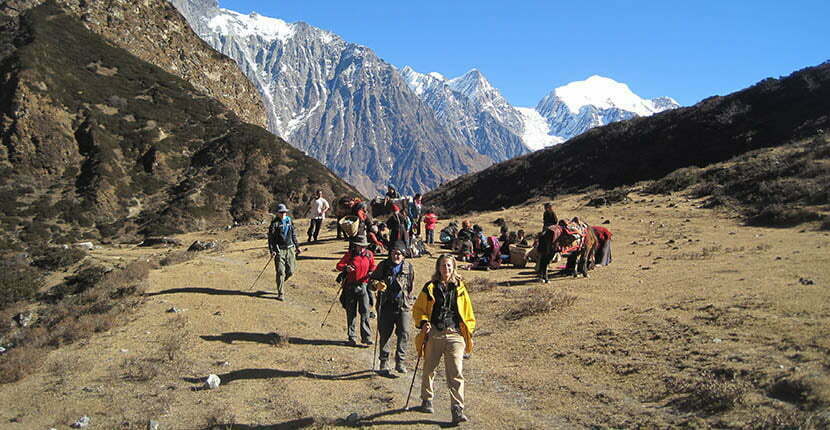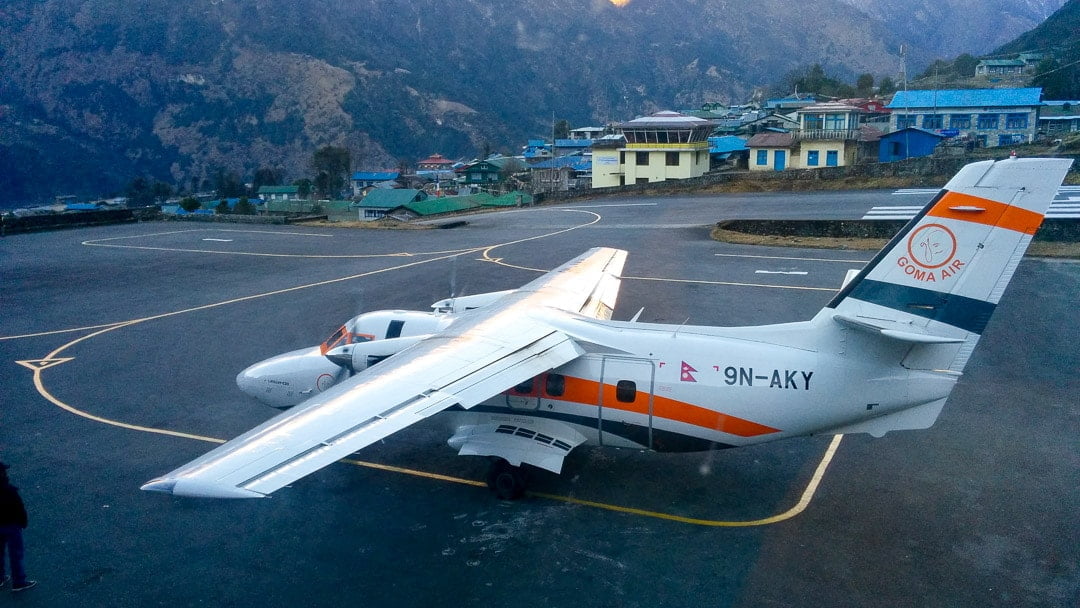The Everest Kongma La Pass Trek is a challenging and off-the-beaten trail in the iconic Everest region, offering a unique and unforgettable adventure for trekkers. The Kongma La Pass, with its impressive altitude, is nestled at 5540 meters. Situated above the Dingboche and offers breathtaking views of the towering mountains of the Everest region, including the highest peak in the world, Mount Everest, and various sections of the Mahalangur Range.
This trek not only offers the chance to witness the stunning natural beauty of the Everest/Khumbu region but also provides an opportunity to delve into the rich culture of the Sherpa people by visiting their villages.
The journey to Everest Kongma La Pass Trek begins with a scenic flight from Kathmandu to Lukla. Followed by a trek along the classic Everest trail. The trek requires previous experience or a strong physical and mental capability, as it involves crossing the pass and traversing through blooming rhododendron forests, river valleys, and villages while enjoying the natural scenery and cultural diversity of the region. Upon reaching the pass, soak in the panoramic views of the majestic peaks of Ama Dablam, Makalu, and Lhotse, Nuptse.
The trek also takes you to the vantage point of Kala Patthar and the Base of the Highest peak of the world. In conclusion, the Kongma La Pass Trek is an exceptional and unforgettable experience. That offers a rare combination of natural beauty, cultural richness, and high-altitude thrills. With proper preparation and a spirit of adventure, trekkers are sure to make lasting memories on this challenging and rewarding journey.
Entry Permits and Requirements:
The Everest Kongma La Pass Trek requires two permits:
1) Sagarmatha National Park Entry Permit and
2) Khumbu Rural Municipality Entrance Permit.
The Nepal Tourism Boards office in Kathmandu or the park’s entrance gate in Monjo can provide you with Sagarmatha National Park Entry Permit for NRS 3000.
The fee for citizens of SAARC nations is NRS 1500.
You must complete the permit application and present your passport or a copy of your passport. You must be in Lukla to obtain the Khumbu Pasang Lhamu Rural Municipality Entrance Permit. The permission costs NRS 2000 and may be acquired at the rural municipality counter on the outskirts of the settlement.
You will not have to worry about waiting for permits since the Alpine Club of Himalaya or our guides will take care of everything.
Meals and drinking water:
Everest Region Trek is one of the most facilitated trekking destinations in the country, providing basic to luxury ones.
In this trial, you will be provided with a variety of cuisine to choose from. Nepali, Tibetan, Indian, western as well as continental meals. As the region has small tea houses to luxury hotels the facilities they provide are basic to grandeur according to your budget.
Similarly, drinking water is accessible with natural water supplies which are untreated, so direct use of the water is not recommended, you may refill boiling water or cold filter water from any of the teahouses. However, if you buy a water purification tablet, chlorine drops or utilize SODIS (sunlight assisted) filtration procedures for further assurance, saving money, and reducing plastic pollution.
Common Breakfast During the trek:
During the trek, various tea houses provide a wide range of breakfasts. The most common breakfast includes Tibetan Bread (fried bread), Chapati (unleavened flatbread). The bread is provided with jam, butter or peanut butter, Scrambles, or boiled eggs, and vegetable curry.
Corn Flakes, Pancakes, Oats, and Muesli are also available. In some of the tea houses, American breakfast is available. Hot drinks including black tea and coffee are available for breakfast. Also, you may find various freshly baked items.
Common Lunch during the trek:
Dhal Bhat (Nepalese traditional food) is the most common meal found along trekking houses. But various varieties of meals are also available. Thukpa (Noodles) soups, Momos ( dumplings), Macaroni, Fried rice, Pizza, Spaghetti, a variety of soups, steaks, potatoes items, Sandwiches, rice with curry, spring rolls, burgers. Plenty of dessert items are also available.
Common Dinner during the trek:
Dhal Bhat (Nepalese traditional food) is the most common dinner. But you can choose from a wide variety. Momos (dumplings), Thukpa (noodle) soups, Macaroni, Pizza, Spaghetti, Sherpa Stew, steaks, potatoes items, fried rice with curry, Raman soups, burgers, and are available along the tea houses.
Most of the tea houses’ menus offer desserts. Rice pudding, Apple pie, fruit snicker, cake, pastries, etc.
Accommodation:
Accommodations are available in trekking lodges, teahouses as well as several hotels all along the trail, providing basic well-maintained, and reasonably luxury 5-star ones with additional needs according to your budget. Tea houses on the trail vary in quality and price, depending on the amenities they feature.
For trekkers who want to Camp, various campsites are available along the.
Transportations:
All the necessary transportation for your trip will be managed by us upon your request. Transportation is provided on a private as well as sharing basis. Solo travelers are provided with sharing or public transportation. Whereas travelers of two and above are provided with private transportation.
Potter and Guide:
Solo trekkers are provided with a single helper both acting as a Potter and Guide. For trekkers above two or more Potters and Guides are provided according to the size of the groups. Every two guest is provided with one potter.
Responsible Tourism:
As responsible for tourism we believe in respecting local communities, their culture, and rules. So, for that region, we would like you to follow some local rules and regulations during the trek. Always ask your guides for permission before doing something in the local community. Keep the environment clean. Help the local community to encourage the positive sides of tourism.
Best Time to Visit?
The best season for trekking to the Everest region is during autumn and spring, the months of September, October, November, March, April, and May.
During the autumn season, the months of September, October, and November the weather is clear with warm temperatures and the visibility is great. As the weather is mild it is very easy to get around the region.
The spring season of March, April, and May are also the best time to visit the Everest region, marking the end of the winter, the spring season brings a change in the topography of the region and the destination comes to life with endless rows of different colored rhododendron, moss and orchid draped trees, colorful undergrowth stretching for miles and the snowy white mountains peaks on the backdrop of clear blue skies.
Monsoon season is not favorable for trekking as the weather gets harsh and it is hard to get around the country with frequent landslides and floods. So usually, monsoon season is avoided by trekkers.
In the winter season, the area receives a high amount of snowfall, covering most of the trail, and access is denied to most of the regions of Everest, making it impossible to trek.
Essential Gears for Everest Kongma La Pass Trek:
- Sunglasses Polarized
- Sun hat
- Backpack (waterproof) (can be rented)
- Refillable water bottles
- Good quality, super-warm 4-season sleeping bag (can be rented)
- Hand towel
- Energy Bars
- Wet wipes
- Toiletries
- Frontal torch and flashlight with spare batteries
- Sunblock and high SPF lip balm
- Map
- Compass
- Penknife
- Wash bag (Toothpaste, Toothbrush, and other personal hygiene items)
- Sewing Kit
- Trekking poles (can be rented)
- Duffel Bag (provided by the company)
Clothing:
- Anorak/parka with hood (waterproof) x 1
- Down jacket x 1
- Fleece x 1
- Thermal top x 2
- T-shirts x 3, long sleeve shirts x 2-3
- Waterproof trousers x 1
- Warm trousers x 2
- Hiking shorts/trousers x 1
- Long thermal pants x 1
- Thermal underwear
- Socks thin and thick x 6
- Hiking boots
- Gaiters
- Comfortable closed shoes (for around camp)
- Mittens and ski gloves
- Balaclava and woolen hat
- Scarf
First Aid kit:
- Imodium or Pepto Bismo capsules for upset stomach or diarrhea.
- Diamox for altitude sickness. The guide will help you to take it.
- One small personal-sized first-aid kit with blister treatments such as moleskin, bands, anti-infection ointments, and muscle relief ointments.
Important Note:
Your safety is of paramount importance to us at the Alpine Club of Himalaya. We have the absolute authority to cancel the trip or change the itinerary, when deemed necessary or when we have reason to believe your safety is at stake. Weather conditions, the health condition of a group member, natural disasters, and such, can contribute to changes in the itinerary when traveling in remote mountainous regions. In these extreme situations, we kindly request that you offer your full cooperation to the trusted leader of the group appointed by the Alpine Club of Himalaya. However, we assure you that we will make every effort to keep to the above itinerary.
Overview
Kongma La Pass Trek, located in the renowned Everest region, is a challenging trekking experience that offers breathtaking views and the thrill of adventure. With an altitude of 5535m, Kongma La Pass is the highest pass in the Everest region, making it a must-visit destination for avid trekkers.
Before embarking on the trek, it is important to note that high-altitude sickness is a potential risk. As one ascends above 3500m, the likelihood of high altitude sickness increases. If symptoms arise, we recommended to cease trekking and seeking secondary treatment. In the case of severe conditions, helicopter rescue services are available throughout the Everest region.
The trek begins with a short flight to Lukla from Kathmandu, which may experience busy traffic during the peak season. In case of flight cancellations or delays, a shared helicopter ride to Lukla can be arranged. During the trek, there will be available lodges and food options, although the daily walking distance is approximately 5-6 hours.
In conclusion, a well-prepared trek to Kongma La Pass is the key to a successful and enjoyable experience. Let us manage the ticket booking process, while you focus on exploring the breathtaking views and thrilling adventures of the Everest region.
Trip Highlights
- Hiking to Kala Patthar, and Everest Base Camp.
- Cross high mountain pass of Kongma La Pass.
- Witness grand panoramic views of the mountains and glaciers in the Everest region.
- Explore Sherpa villages and rural settlements.
- The trek starts with a scenic flight from Kathmandu to Lukla.
- Trek through blooming forests, river valleys, and villages.
- Learn about the rich culture and traditions of the mountain people.
















Write a Review